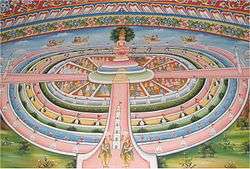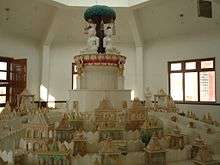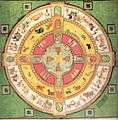Samavasarana

| Part of a series on |
| Jainism |
|---|
 |
|
Jain prayers |
|
Ethics |
|
Major sects |
|
Festivals |
|
|
In Jainism, Samavasarana or Samosharana "Refuge to All" is a term for the divine preaching hall of the Tirthankara. The word samavasarana is derived from two words, sama meaning general and avasara meaning opportunity. A place where all have a common opportunity of acquiring the wisdom.[1] The divine pavilion is built by heavenly beings (devas) after the tirthankara attain omniscience (Kevala Jnana).[2] The theme of Samavasaranas has been popular in Jain art.[3]
Hall

In samavasarana, the tirthankara sat on a throne without touching it (about two inches above it).[4] Around the tirthankara sit the ganadharas (chief disciples). Living beings sit in the following order:[5]
- In the first hall, ascetics
- In the second hall, one class of deva ladies
- In the third hall, aryikas (nuns) and laywomen
- In the next three halls, three other class of deva ladies
- In the next four halls, the four classes of devas (heavenly beings)
- Men, in the eleventh hall
- Animals, in the last hall
According to Jain texts, there would be four wide roads with four huge columns, Manasthamba (literally, pride pillar), one in each side.[6] The total size of the hall varies depending upon the height of the people in that era. The size of Rishabhadeva's samavasarana was 12 km2 (4.6 sq mi).[7]
Effects of the Samavasarana

In samavasarana, a tirthankara sits facing the east, but appears to be looking in all directions.[5] Tirthankara sits on a soft cushion while preaching the Jain philosophy in plain terms.[8] All humans and animals can understand the discourse. Jain scriptures say that all creatures who listen would become less violent and greed less.[9] The speech of the tirthankara is distinctly heard by every one present.[5]
Gallery
 Jain manuscript page with Mahavira teaching to all creatures in Samavasarana, western India, c. 1500-1600, gouache on paper
Jain manuscript page with Mahavira teaching to all creatures in Samavasarana, western India, c. 1500-1600, gouache on paper Samavsarana of Mahavira as depicted in 19th-century art from Mysore.
Samavsarana of Mahavira as depicted in 19th-century art from Mysore. Painting of Samavasarana (Assembly hall) of a Jain Tirthankara. It depicts various beings who come to hear the preachings of the Jina peacefully
Painting of Samavasarana (Assembly hall) of a Jain Tirthankara. It depicts various beings who come to hear the preachings of the Jina peacefully Samosharan depiction
Samosharan depiction
See also
Notes
- ↑ Jain 2008, p. 97.
- ↑ http://philtar.ucsm.ac.uk/encyclopedia/jainism/jains.html Jains
- ↑ Wiley, Kristi L. (2009), Scarecrow Press, p. 184, ISBN 9780810868212 https://books.google.co.in/books?id=kUz9o-EKTpwC Missing or empty
|title=(help) - ↑ Jain 2008, p. 95.
- 1 2 3 Jain 2008, p. 96.
- ↑ Jain 2008, p. 93.
- ↑ "APPENDIX 14". jainworld.com.
- ↑ Jain 2008, p. 98.
- ↑ Pramansagar 2008, p. 39-43.
References
- Rai, Champat Jain (2008), Risabha Deva (Second ed.), India: Bhagwan Rishabhdeo Granth Mala, ISBN 9788177720228
- Pramansagar, Muni (2008), jain tattvavidya, India: Bhartiya Gyanpeeth, ISBN 978-81-263-1480-5
Further reading
- Champat Rai Jain (1929). "X: THE SAMAVASARANA". Risabha Deva - The Founder of Jainism. K. Mitra, Indian Press, Allahabad. p. 126.
External links
| Wikimedia Commons has media related to Samavasarana. |